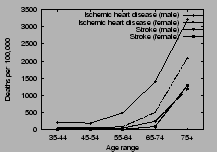 |

Atheroma1 is the main killer in the western world. Most deaths in Ireland are due to cardio-vascular events and the majority of these are due to myocardial infarction.
| Cause of Death | % |
|---|---|
| Circulatory Diseases | 43 |
| Malignant Neoplasms | 24 |
| Respiratory Diseases | 15 |
| Injury and Poisioning | 6 |
| Other | 12 |
The main contributors to the formation of atheroma are;
Atheroma causes problems in several ways;
Plaque like material accumulates on the inside of the arteries and this results in a narrowing of the vessels with poor blood flow to the tissues down stream. The plaque may rupture with ejection of athermatous material into the circulation, this material will cause downstream blockages and ischaemia. The resultant ulcerated area in the plaque acts as a nidus for the formation of small clots which consist primarily of platelets, these clots in turn may break off and embolise into the distal circulation. If the clotting is exuberent the clot may actually block the artery. Another complication is haemmorhage into the plaque, which will result in acute narrowing of the vessel with superimposed thrombosis and occlusion.
If we take the example of coronary artery disease we can see parallels with arterial disease in other locations;
| Pathophysiology | Stenosis (pressure drop on distal vasodilatation) | More severe stenosis (pressure drop at rest) | Distal embolisation | Occlusion or embolisation |
| Coronary circulation | Angina on exertion | Angina at rest (Unstable angina) | ? | Myocardial infarction |
| Carotid circulation | ? | ? | Transient ischaemic attack | Stroke |
| Lower limb circulation | Claudication | Rest pain | Blue toe syndrome | Ulceration and necrosis |
Mitchell et al [MW+97] noted that retinal artery emboli were
detectable in a large number of asymptomatic elderly australians.
| Age | Rate (%) |
|---|---|
| Younger than 60 | 0.8 |
| 60-69 | 1.4 |
| 70-79 | 2.1 |
| Older than 80 | 1.5 |
